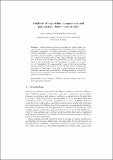Files in this item
Analysis of algorithm components and parameters : some case studies
Item metadata
| dc.contributor.author | Dang, Nguyen | |
| dc.contributor.author | De Causmaecker, Patrick | |
| dc.contributor.editor | Battiti, Roberto | |
| dc.contributor.editor | Brunato, Mauro | |
| dc.contributor.editor | Kotsireas, Ilias | |
| dc.contributor.editor | Pardalos, Panos M. | |
| dc.date.accessioned | 2019-04-23T12:30:10Z | |
| dc.date.available | 2019-04-23T12:30:10Z | |
| dc.date.issued | 2018 | |
| dc.identifier | 258271693 | |
| dc.identifier | 59b16b06-71ce-4e6a-b935-fa9975d71c9c | |
| dc.identifier | 85059947815 | |
| dc.identifier | 000611949200025 | |
| dc.identifier.citation | Dang , N & De Causmaecker , P 2018 , Analysis of algorithm components and parameters : some case studies . in R Battiti , M Brunato , I Kotsireas & P M Pardalos (eds) , Learning and Intelligent Optimization : 12th International Conference, LION 12, Kalamata, Greece, June 10–15, 2018, Revised Selected Papers . Lecture Notes in Computer Science (Theoretical Computer Science and General Issues) , vol. 11353 , Springer , Cham , pp. 288-303 , Learning and Intelligent Optimization Conference (LION 12) , Kalamata , Greece , 10/06/18 . https://doi.org/10.1007/978-3-030-05348-2_25 | en |
| dc.identifier.citation | conference | en |
| dc.identifier.isbn | 9783030053475 | |
| dc.identifier.isbn | 9783030053482 | |
| dc.identifier.issn | 0302-9743 | |
| dc.identifier.other | crossref: 10.1007/978-3-030-05348-2_25 | |
| dc.identifier.other | ORCID: /0000-0002-2693-6953/work/55643847 | |
| dc.identifier.uri | https://hdl.handle.net/10023/17581 | |
| dc.description.abstract | Modern high-performing algorithms are usually highly parameterised, and can be configured either manually or by an automatic algorithm configurator. The algorithm performance dataset obtained after the configuration step can be used to gain insights into how different algorithm parameters influence algorithm performance. This can be done by a number of analysis methods that exploit the idea of learning prediction models from an algorithm performance dataset and then using them for the data analysis on the importance of variables. In this paper, we demonstrate the complementary usage of three methods along this line, namely forward selection, fANOVA and ablation analysis with surrogates on three case studies, each of which represents some special situations that the analyses can fall into. By these examples, we illustrate how to interpret analysis results and discuss the advantage of combining different analysis methods. | |
| dc.format.extent | 695728 | |
| dc.language.iso | eng | |
| dc.publisher | Springer | |
| dc.relation.ispartof | Learning and Intelligent Optimization | en |
| dc.relation.ispartofseries | Lecture Notes in Computer Science (Theoretical Computer Science and General Issues) | en |
| dc.subject | Forward selection | en |
| dc.subject | fANOVA | en |
| dc.subject | Ablation analysis with surrogates | en |
| dc.subject | Parameter analysis | en |
| dc.subject | QA75 Electronic computers. Computer science | en |
| dc.subject | QA76 Computer software | en |
| dc.subject | Computer Science (miscellaneous) | en |
| dc.subject | NS | en |
| dc.subject.lcc | QA75 | en |
| dc.subject.lcc | QA76 | en |
| dc.title | Analysis of algorithm components and parameters : some case studies | en |
| dc.type | Conference item | en |
| dc.contributor.institution | University of St Andrews. School of Computer Science | en |
| dc.identifier.doi | 10.1007/978-3-030-05348-2_25 |
This item appears in the following Collection(s)
Items in the St Andrews Research Repository are protected by copyright, with all rights reserved, unless otherwise indicated.

